LEED Buildings
The U.S. Green Building Council created the Leadership in Energy and Environmental Design, or LEED, construction sustainability rating system in 1990. LEED is based on a holistic design approach that integrates energy efficiency, the environment, and the design/construction processes. LEED offers points that encourage an exceptional work place environment for end users as well as creating a sustainable and energy efficient building. Based upon the earned number of credits, or points, buildings receive one of the following rankings:
- Certified
- Silver
- Gold
- Platinum
LEED Silver is the Butler standard for new construction and major renovations, but Gold or higher is strived for whenever possible. Even small renovation projects on campus incorporate the LEED sustainability concepts.

Science Complex
The Science Complex achieved LEED Gold in 2023. The $100 million investment includes high-tech classrooms that promote learning by doing, labs that mimic the set-up at top research companies, and work spaces encouraging cross-disciplinary collaboration.
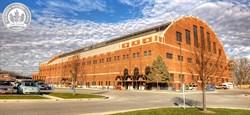
Hinkle Fieldhouse
The administration wing of Hinkle Fieldhouse, renovated in 2014, achieved LEED Gold in 2016. Tours are available upon request through Butler Athletics.
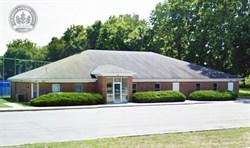
Athletic Annex
The Athletic Annex achieved LEED Gold in 2017. Click here for more information on the sustainability aspects of this facility. Tours are available upon request through Butler Athletics.
Howard L. Schrott Center for the Arts
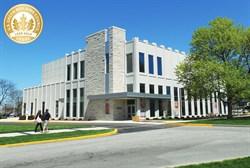
Opened in 2013 with LEED Gold Certification, the Howard L. Schrott Center for the Arts is Butler’s Second LEED Gold Certified building.
The facility uses 55 percent less water and 22 percent less energy (saving the University an estimated $19,000 per year based on 2013 energy costs) than a typical building its size because of construction measures that include:
- A white roof that reflects heat rather than absorbs it.
- Dual-pane insulated window assemblies featuring a thermal break.
- Energy-efficient light fixtures.
- Motion and occupancy sensors.
- Low-flow restroom fixtures.
- A rain garden that captures and filters storm water runoff.
- Pervious asphalt that further reduces storm water runoff.
- Green power credits were purchased for 100 percent of the projected electricity consumption for two years.
- 78 percent of the construction waste was recycled and thus diverted from landfills.
- 75 percent of the materials used for construction were extracted and manufactured from within 500 miles of the project site including limestone on the building exterior.
- This facility will be cleaned using green cleaning products.
College of Pharmacy and Health Sciences Addition
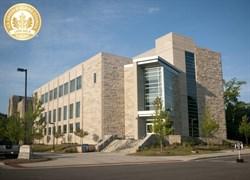
Opened in 2009 with LEED Gold Certification, the College of Pharmacy and Health Sciences addition was Butler’s first LEED certified building. This project incorporated:
- Bicycle racks were installed to encourage occupants to reduce their greenhouse gas emissions by riding bicycles rather than driving vehicles
- Dual flush toilets which allow the occupant to select a lower water flow option when a full flush is not needed
- Low-flow urinals, sinks and showers to conserve an estimate of almost 300,000 gallons/year. That’s enough water to fill up the HRC lap pool over two and a half times!
- Energy efficient equipment helps make the building 30% more energy efficient than a standard building of its type and size
- Building is constructed of more than 30% recycled content
- 40% of the building materials were extracted and manufactured within 500 miles of Butler’s campus
- All adhesives, sealants, paints, coatings and carpet systems contain low-levels of Volatile Organic Compounds (VOCs)
- Improved the indoor environment by:
- Providing over 90% of regularly occupied rooms with access to windows
- Providing over 90% of occupants with individual lighting controls
- Providing over 50% of offices with a thermostat to control their individual environment
- Using Green cleaning products to maintain the appearance of the building
Fairview House
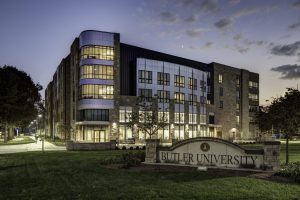
This residence hall has over 650 beds, and was completed in 2016 through a partnership with American Campus Communities. Fairview achieved LEED Gold in 2017.
- A white roof that reflects heat rather than absorbs it.
- Alternative Transportation: Public Transportation (IndyGo) & Bike Rack Storage
- Energy-efficient light fixtures.
- Reduced Water Use was achieved with low flush fixtures which will decrease potable water by more than 46%, resulting in 3.5 million gallons of water saved per year
- Responsible Material Choices for over 85% of construction waste being diverted from landfills
- Improved Indoor Environmental Quality: 90% of all regulary occupied areas have a view of the exterior
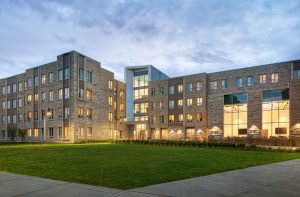
Irvington House
This residence hall has over 630 beds, and was completed in 2018 through a partnership with American Campus Communities. Irvington achieved LEED Gold in 2018. It was recognized for:
- Reduced Water Use was achieved with low flush fixtures which will decrease potable water by more than 46%, resulting in 3.5 million gallons of water saved per year
- Responsible Material Choices for over 85% of construction waste being diverted from landfills
- Improved Indoor Environmental Quality: 90% of all regulary occupied areas have a view of the exterior
- Maximizing Open Space with 60,000 square feet is vegetated open space while over 32,000 square feet is other paving
- Alternative Transportation: Public Transporation (IndyGo) & Bike Rack Storage
- White roof was selected to dissipate heat and avoid artificially elevating ambient temperatures
- Reduced Energy Consumption by utilizing effective and efficient lighting design results in 50% savings in lighting energy use
Dugan Hall
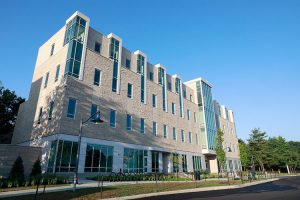
The latest new construction on the campus, the home of the Lacy School of Business was completed in August 2019, achieving LEED Gold upon opening.
- Maximized Open Space with 72,000 SF of project boundary remaining and 60% of vegetation preserved
- White roof was selected to dissipate heat and avoid artificially elevating ambient temperatures
- Alternative Transportation: Public Transporation (IndyGo) & Bike Rack Storage
- Reduced Water Use was achieved with low flush fixtures which will decrease potable water by more than 46%, resulting in 3.5 million gallons of water saved per year
- Reduced Energy Consumption – 24% energy savings compared to a baseline building model during construction, and the building uses 23% less electricity and 44% less natural gas
- Efficient Lighting Design through use of LED fixtures and motion controlled fixtures
- Improved Indoor Environmental Quality – Variable speed air handler to efficiently move air throughout the space
- Natural Lighting was often used in lieu of artificial for energy savings and environment
- Low Emitting Materials – Low volatile organic compound (VOC) was used such as adhesives, sealants, paints, flooring systems, etc.
- Responsible Material Choices for over 85% of construction waste being diverted from landfills

